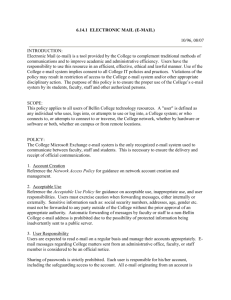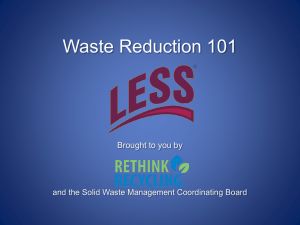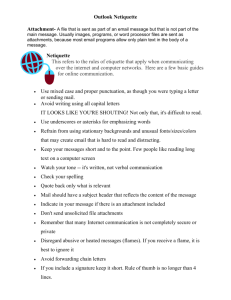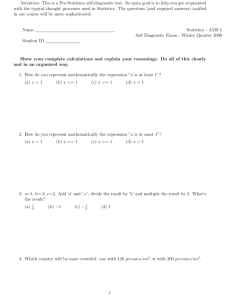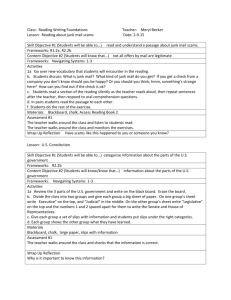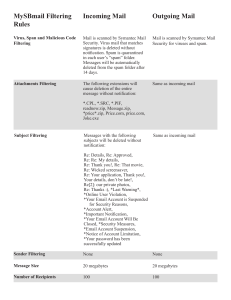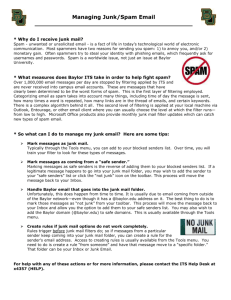Know Your Netiquette
advertisement
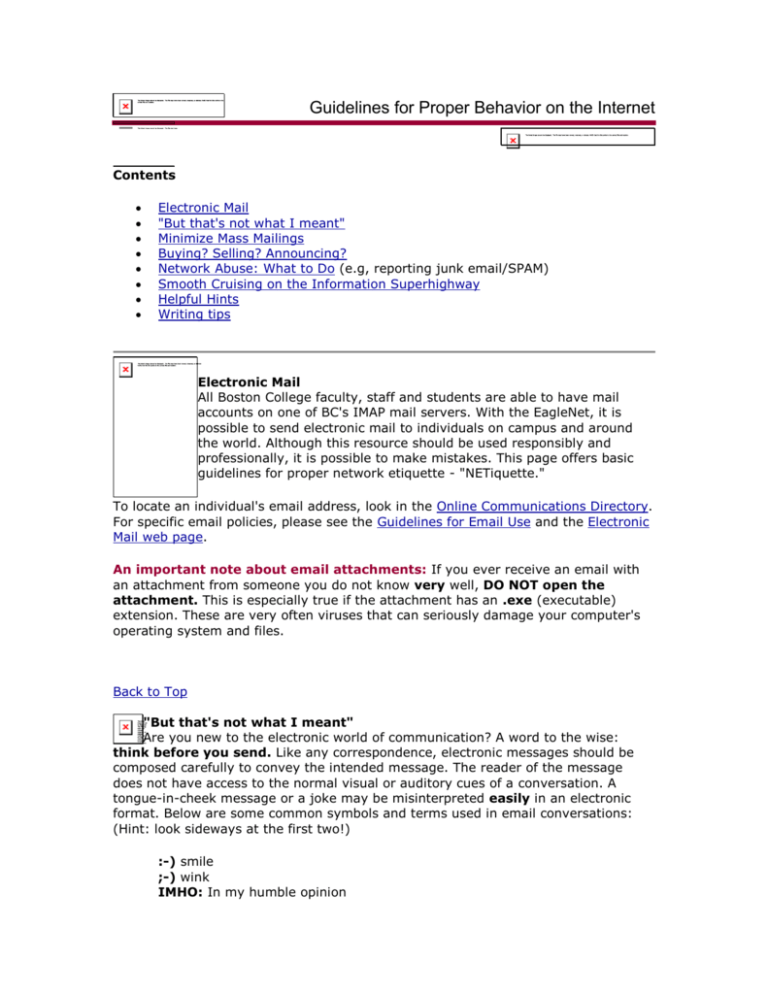
Guidelines for Proper Behavior on the Internet Contents Electronic Mail "But that's not what I meant" Minimize Mass Mailings Buying? Selling? Announcing? Network Abuse: What to Do (e.g, reporting junk email/SPAM) Smooth Cruising on the Information Superhighway Helpful Hints Writing tips Electronic Mail All Boston College faculty, staff and students are able to have mail accounts on one of BC's IMAP mail servers. With the EagleNet, it is possible to send electronic mail to individuals on campus and around the world. Although this resource should be used responsibly and professionally, it is possible to make mistakes. This page offers basic guidelines for proper network etiquette - "NETiquette." To locate an individual's email address, look in the Online Communications Directory. For specific email policies, please see the Guidelines for Email Use and the Electronic Mail web page. An important note about email attachments: If you ever receive an email with an attachment from someone you do not know very well, DO NOT open the attachment. This is especially true if the attachment has an .exe (executable) extension. These are very often viruses that can seriously damage your computer's operating system and files. Back to Top "But that's not what I meant" Are you new to the electronic world of communication? A word to the wise: think before you send. Like any correspondence, electronic messages should be composed carefully to convey the intended message. The reader of the message does not have access to the normal visual or auditory cues of a conversation. A tongue-in-cheek message or a joke may be misinterpreted easily in an electronic format. Below are some common symbols and terms used in email conversations: (Hint: look sideways at the first two!) :-) smile ;-) wink IMHO: In my humble opinion BTW: By the way Back to Top Minimize Mass Mailings! Many offices use mass mailings to inform the community of upcoming events or seminars. In an electronic environment, this "mass communication" can wreak havoc. Electronic mass mailings appear to be easy and free. Easy they are, but "free" they are not. There are hidden costs: networks become clogged; mail server space is chewed up, and folks get irritated when their mailboxes are stuffed with "electronic junk mail," also known as SPAM. Everyone's time is valuable. One person's "cause" or "concern" may mean nothing to the next. People who have no interest in your message may become upset and complain vocally. With this in mind, the basic rule is, "Don't send a message to anyone unless you absolutely know that he/she wants to receive it." Oftentimes, many of the topics and events which one would like to mention in a mass mailing can be publicized using BCInfo, the Campus Wide Information System. Some free and easy ways to advertise events electronically are through the electronic events calendars of the BC Chronicle, the Student Affairs Office the Office of the Dean for Student Development. All of these services can be accessed from the BC Events, Schedules and Calendars Page, accessible via the BCInfo Page. Back to Top Network abuse: what to do? Use of network resources has exploded campus-wide. No one is expected to be an "electronic guru" from Day One, and there will be times when you may "violate" rules unconsciously. While we can't control "junk mail" (also known as SPAM) received from off-campus sources, Information Technology will vigorously pursue any on-campus violations. If you receive electronic junk mail/SPAM: Be self-policing. If it comes from an on-campus (@bc.edu) address, you can send the individual an e-mail explaining that this is an improper use of the network, and you'd appreciate not receiving messages in the future. Be respectful and know that everyone is not an "expert." Educate, don't berate those who are less knowledgeable. You can also just delete it as well. Do not respond to SPAM from off campus. Electronic spammers often use a clever tactic of offering a supposed way for you to "unsubscribe" from their lists if you don't want to receive future emails. While unsubscribing is used by legitimate email listservs, this is also a way for a spammer to confirm that 1.) you actually exist and 2.) that you use your email. So if you didn't specifically subscribe to a listserv to receive the email in the first place, don't reply to it -just delete it. If it comes from off-campus, forward a copy of the email to the originator's ISP (Internet Service Provider) If the email is offensive to you, you can forward a copy of it to the originator's ISP (Internet Service Provider). Most ISP's have email addresses set up specifically for reporting instances of SPAM and other offensive email. To figure out where the email originated, look at the From: field of the SPAM/junk email. Take the information after the @ sign in the email address and add "abuse@" to the beginning. (e.g., abuse@mediaone.net, abuse@aol.com, abuse@yahoo.com) You will most likely receive an auto-generated response that your complaint has been received and that they will investigate its origin and take whatever action is possible. Please be aware that individuals who send junk email/SPAM are very resourceful, and have many ways of sending email that appears to come from a particular ISP when in actuality it does not. If you use the network improperly: You will be contacted by a member of Information Technology regarding proper network usage. Expect several responses (some harsh) from colleagues. Don't get into a war of words. The responses are well-intended and should be taken seriously, but not personally. If you suspect abuse of our electronic environment: Report it immediately, with any evidence, to abuse@bc.edu. Above all, be familiar with BC's policies, procedures and practices - know your rights and responsibilities! Back to Top Smooth Cruising on the Information Superhighway! Connection to EagleNet, Boston College's network, lets you interact with others on campus and around the world. This connection also provides access to a wealth of ever-expanding information right at your fingertips! Using these "highways" of information doesn't come free from responsibility, however. Accessing EagleNet and the Internet, both on and off campus, falls under the existing policies for the use of computing resources. Simply put, EagleNet is intended for professional, not personal use. Venturing outside of BC's network is similar to moving from local street to highway driving. Realize that other networks have "rules of the road," and they may be different from ours. It is important to note that it is a violation of many regulations and laws to send harassing, threatening or abusive electronic communications. It is also illegal to use the network to distribute copyrighted materials without express permission from the author or publisher, including software applications. Copies of Boston College's policies and procedures for computing resources are available in the Boston College Policies and Procedures Manual, the Boston College Employee Handbook and the Boston College Student Guide. Policies and procedures for external networks (NEARnet, NSFnet) are available electronically. For information on how to access these documents, call x2-HELP or write to help.center@bc.edu. Back to Top Helpful Hints Never use ALL CAPS. It is the electronic equivalent of SHOUTING. Never send a broadcast message. This means sending a message to everyone using e-mail. This is commonly viewed as electronic "junk mail," no matter how well-intended the message is. Avoid mass electronic mailings. They clog the network and slow things down for every one, including yourself! Writing tips Grammar (and we're not talking about your mom's mom…) As in "snail" mail, the accepted rules relating to grammar and spelling still prevail. Utilize that spell checker in Communicator or Simeon. Or perhaps compose your email in Word first and utilize the grammar checker as well. Salutations (the dying art in email) You may consider it a memo; others may consider it a personal communication, so try to use Dear Nick or Dear Mr. Fyooreeno unless you're emailing your friends or close family. The Subject box (getting your message read) Most people get electronic reams of emails, and many tend to skim their inboxes quickly. If you want your email to be read, try to highlight its importance with a subject line that will pique curiosity. Try to avoid ALL CAPS as it is seen as SHOUTING and is often interpreted as SPAM (unwanted solicitations or junk email). The message (short but sweet) Two or three short paragraphs is usually the maximum most people can (or want to) digest at one sitting. (Unless this is a personal email, of course.) Mimic the tried-but-true Who What Where When and Why - this makes a message easy to read and digest. Attachments (less is more) Try to remember that not everyone has a super fast connection. There are many folks still putting along the Internet on a 28k modem connection. If you send someone a huge attachment it could take hours to download - a source of great frustration. So unless it's vital to your communication, try to avoid attachments. Little things (that mean a lot) Always include a phone number and web address - if you have one - at the bottom of your email. Many people have "signature files" that automatically appear at the bottom of every email. In Simeon, go under Tools, Options, then Edit and you will see a place to enter a signature file. In Communicator, you will need to create a text file and then choose this text file to be your signature file. To do so, choose Preferences from the Edit menu; click on Mail and Newsgroups, then Identity. You will see a white box for a signature file. Click on the Choose button, locate the text file you created on your hard drive and you are set! Other tips - break up your email into smaller paragraphs and use asterisks for bolding (not every email program will accept traditional bolding, so to be *sure*, you can use asterisks). Back to Top Computing & Communications Home Page | BCInfo Copyright 1998 - The Trustees of Boston College URL: http://www.bc.edu/bc_org/tvp/IT/netiquette/netiquette.shtml Last Update: July 20, 2001 This page provided by the Office of Information Technology
